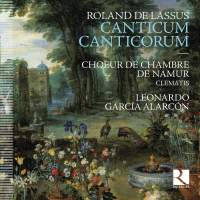Texte paru dans: / Appeared in: |
|
|
Outil de traduction ~ (Très approximatif) |
|
|
Reviewer: Barry
Brenesal I can’t find another currently available recording of the Canticum Canticorum, a series of eight motets composed by Lassus over a period of roughly 30 years. It is a curious work, not least because of the selection the composer made among the Song of Songs’s many verses. He chose to set some of its most sensuous poetry, and he did so in a manner that emphasized canonic and imitative counterpoint and shrewdly placed chromatic progressions. Jérôme Lejeune in his liner notes to the release considers it odd that Lassus ignored the “expressive and descriptive techniques common to the madrigal at the time,” but it’s just possible that was the intent. The composer manages to create a sound world that is at once musically exalted, yet textually sensuous: a paradox that would also appear in a very different context in the music of a much later student of the Franco-Flemish school, Gabriel Fauré. There are competing versions of the Missa super Susanne un jour. Though I haven’t heard that of Stimmwerck and La Villanella Basel on Aeolus 10053, Jeremy Summerly’s with his Oxford Camerata (Naxos 8.550842) makes for interesting comparison. Summerly, in general noted for his energetic pacing and emphasis on transparent lines, takes 5:42 for the Kyrie, and 5:38 for the Agnus Dei. Yet Alarcon’s movements race in at 3:47 and 3:30, respectively. As the tempos are relatively consistent throughout, the difference is very noticeable at any given time. There is also a higher tessitura to Alarcon’s Chœur de Chambre de Namur, thanks to a range of factors—in particular pitching the movements roughly a half step up, and direction that makes the conductor’s bright-sounding sopranos stand out from all the other, well-blended voices. The group performs well enough, a very few ragged entries to one side, and does justice to the contrapuntal complexities of the Canticum Canticorum in particular. On the other hand, the strongly reverberant sound of Stavelot’s Saint-Sébastien Church and the larger numbers the choir deploys in the Mass mitigates against their complete success in the latter work, even if you set to one side the rather hectic pacing. Still, there’s no other choice when it comes to the Canticum Canticorum. So while I still prefer Summerly in the Mass, Alarcon receives the recommendation for the latter. | |
|
|
|
|
Cliquez l'un ou l'autre
bouton pour découvrir bien d'autres critiques de CD |
|




